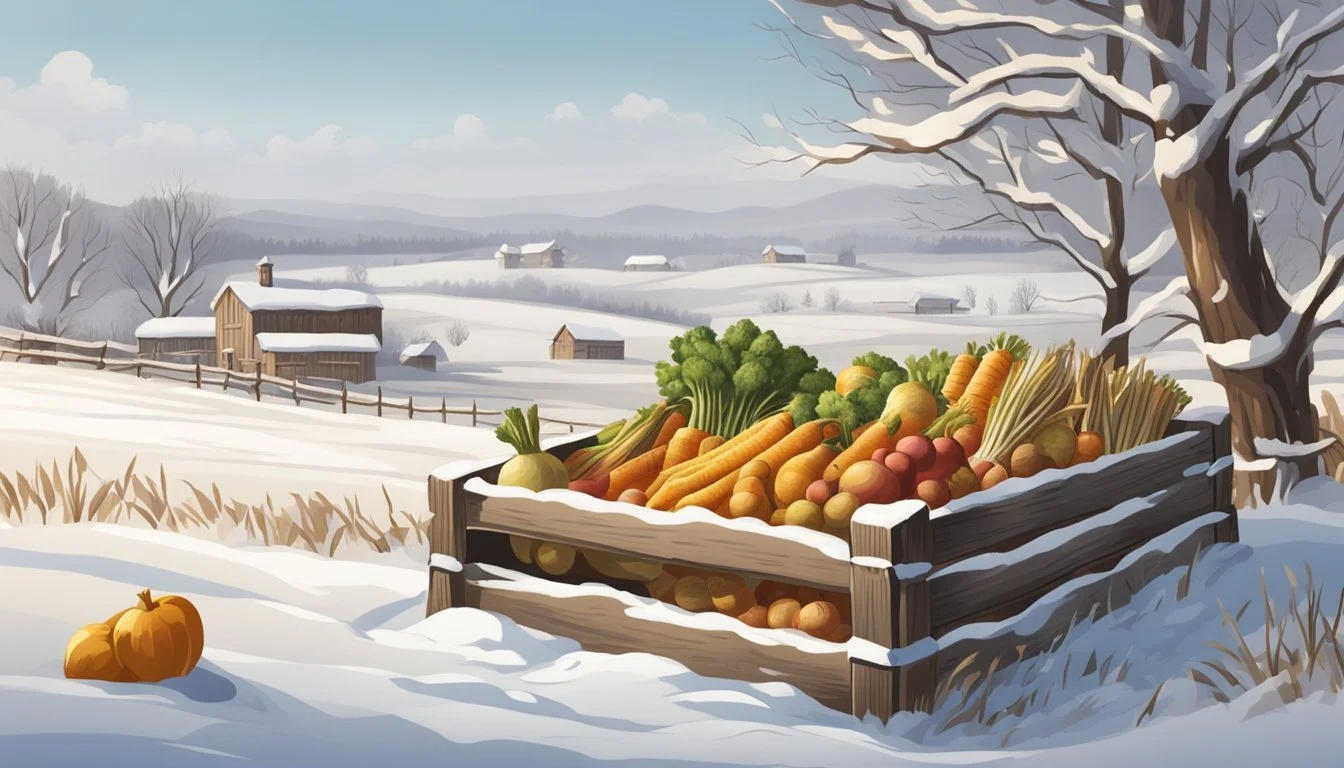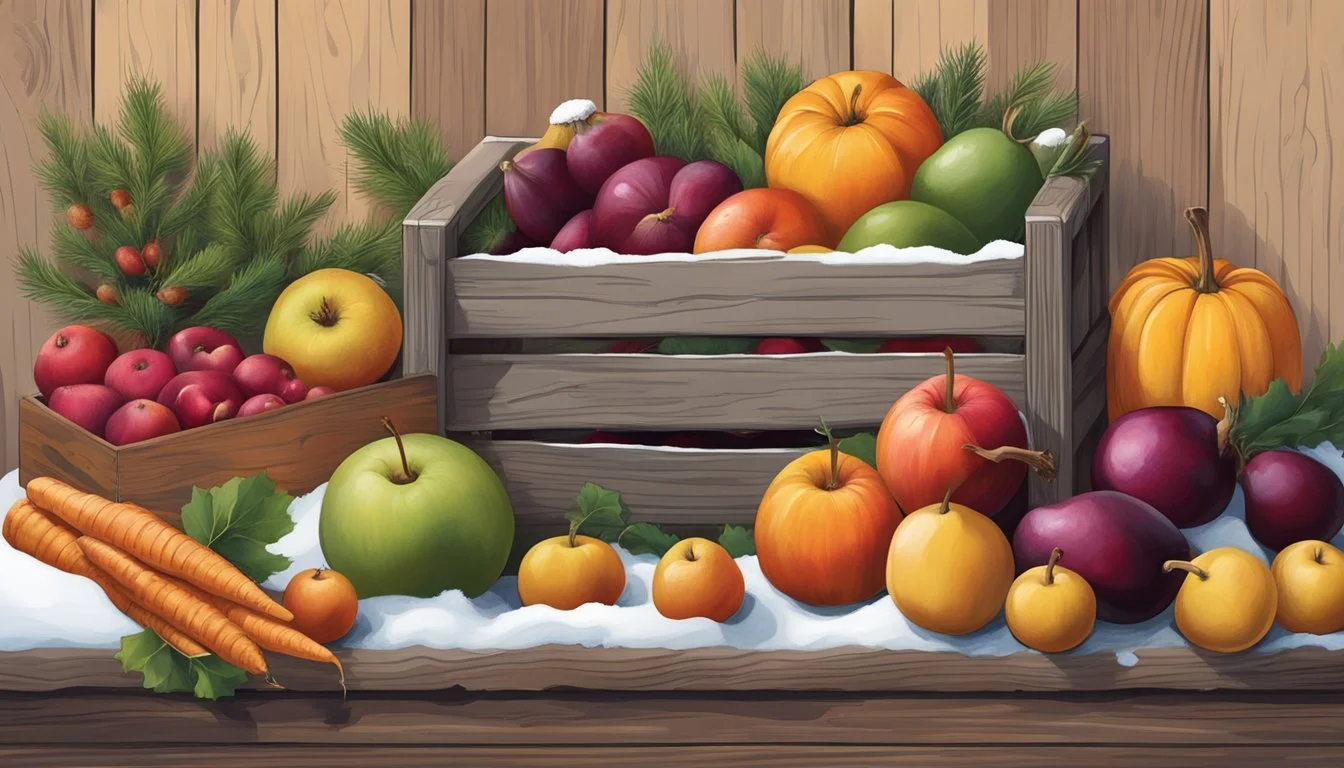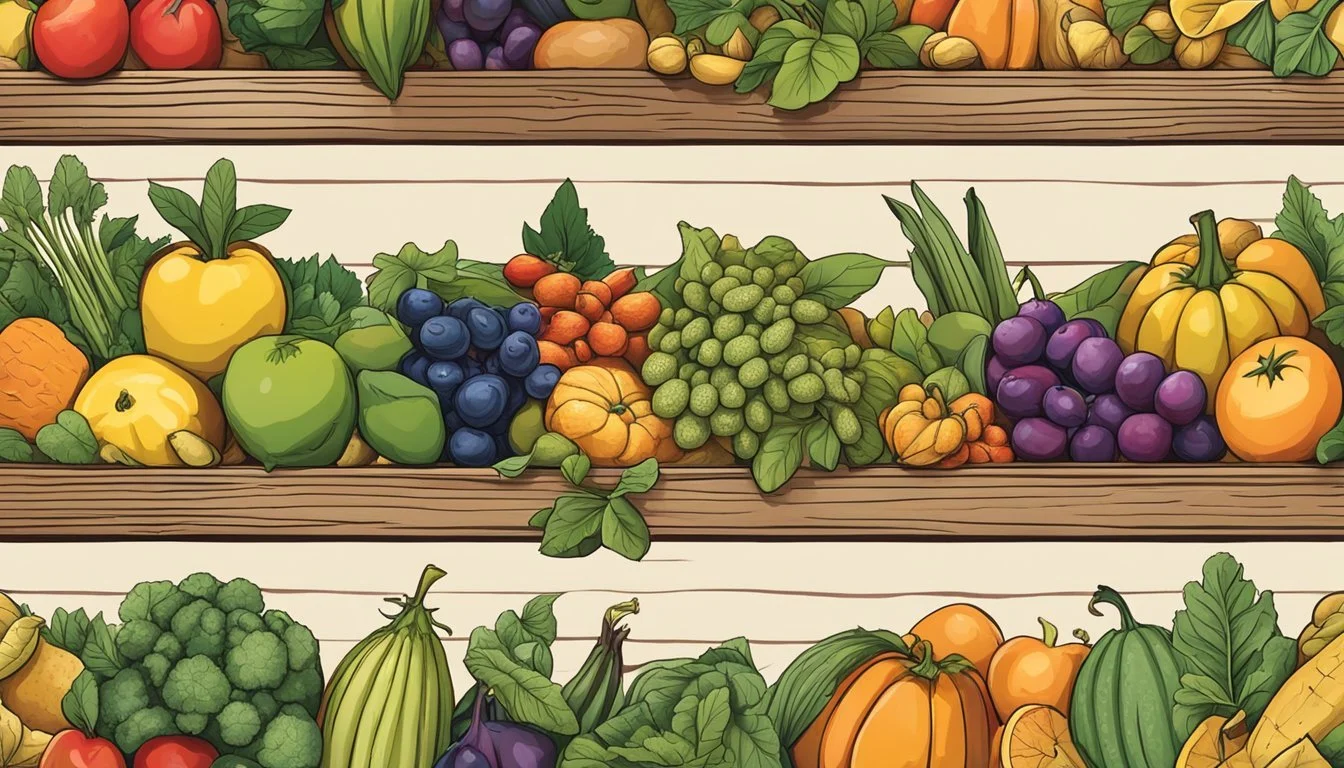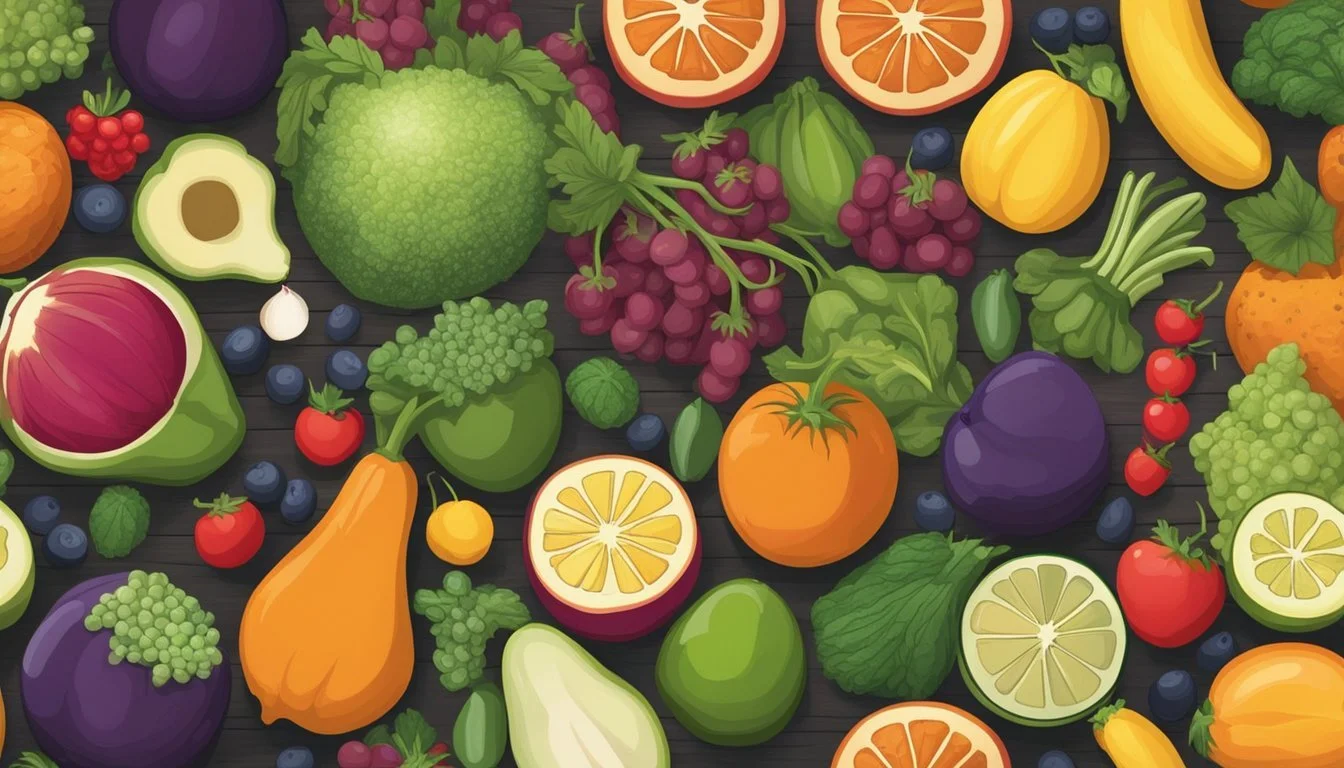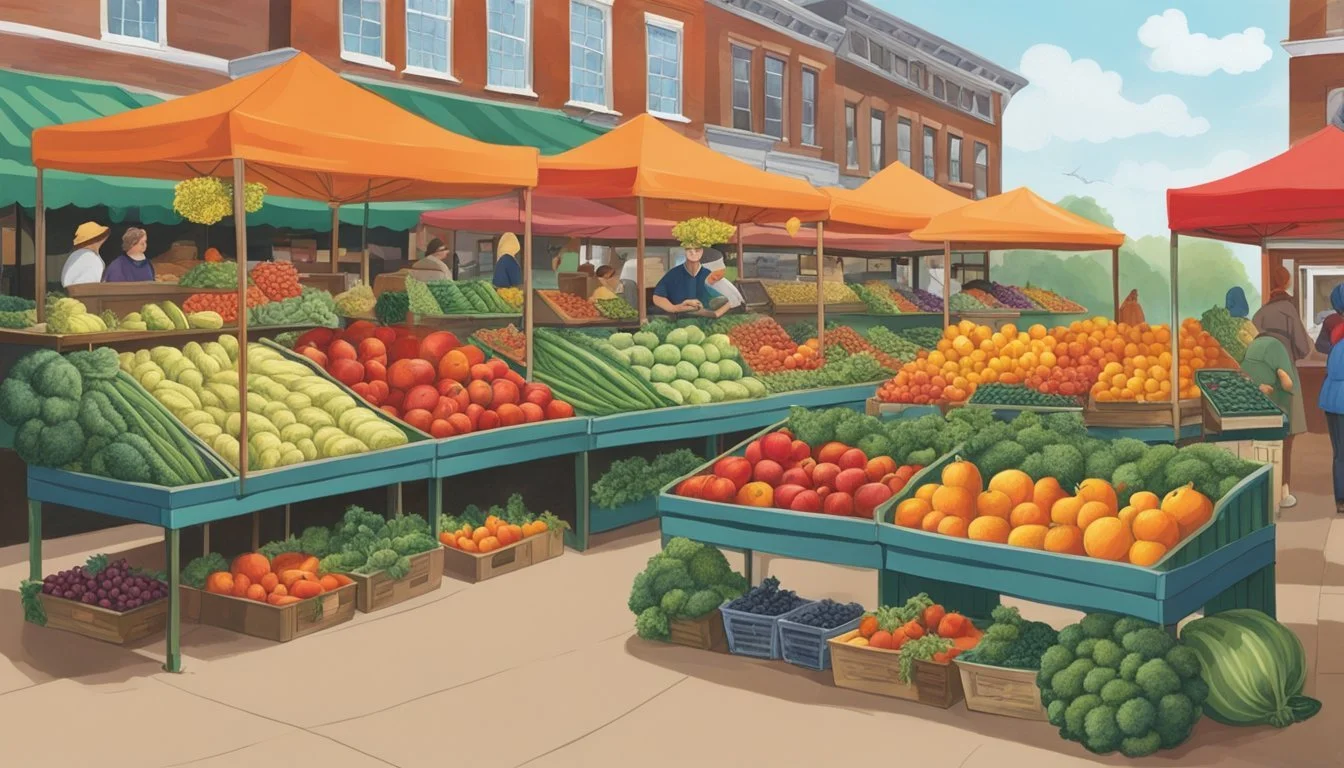Ohio Seasonal Fruit & Vegetables in December
Your Fresh Guide
This Article is Part of our Ohio Seasonal Fruit & Veg Calendar
December in Ohio marks a time of transition, where the last hints of fall give way to the onset of winter. This change brings a shift in the fresh produce available, with many fruits and vegetables reaching the peak of their season. The colder month does not hinder Ohioans from enjoying a variety of seasonal produce, thanks to the state's diverse agriculture and modern storage techniques that extend the availability of many crops beyond their typical harvest periods.
During this month, root vegetables like beets and carrots (how long do carrots last?), as well as winter squash, continue to be in abundance. These hearty vegetables can withstand the chilling temperatures and even become sweeter after a frost. Additionally, leafy greens such as kale (What wine goes well with kale?) and collards thrive in the cold, offering a fresh burst of nutrition during the darker days of the year.
Ohio’s winter does not entirely preclude fruit harvests; apples stored from the fall harvest remain crisp and flavorful, while indoor greenhouse growing practices may provide fresh herbs and greens. Importantly, consumers can leverage these seasonal offerings to ensure freshness, support local agriculture, and benefit from the nutritional best that December’s harvest has to offer.
Overview of Ohio's Seasonal Cycles
In Ohio, the seasonal cycles dictate the availability of fresh fruits and vegetables. Spring in Ohio brings the first bounty with asparagus, radishes, and tender greens like lettuce. The warming temperatures and ample rainfall allow for a fresh start to the growing season.
As the region progresses into summer, farmers' markets and gardens become vibrant with an array of selections. Berries such as strawberries and blueberries reach peak ripeness, and stone fruits like peaches emerge. Summer squash, tomatoes, and corn also hit their stride, providing plentiful options for local consumption.
Moving into fall, Ohio's harvests shift again as the weather cools. Apples and pears ripen on the trees, while root vegetables like carrots and potatoes are dug from the cooling ground. Pumpkins and squashes become staples, reflecting the traditional harvest season.
The winter season poses challenges due to the cold climate; however, modern storage techniques ensure many fall-harvested fruits and vegetables remain available. Hardy greens like kale and storage crops such as onions extend the season. Ohioans utilize these methods to enjoy local produce year-round.
Season Fruits Vegetables Spring Strawberries, Radishes Lettuce, Asparagus Summer Peaches, Blueberries Corn, Summer Squash Fall Apples, Pears Pumpkins, Root Vegetables Winter Stored Apples, Pears Onions, Kale
These cycles demonstrate how Ohio's climate and agricultural practices influence the rhythm of food availability, ensuring residents can enjoy a variety of fresh produce throughout the year.
December's Seasonal Produce in Ohio
In December, residents of Ohio can enjoy a variety of locally grown produce despite the cold weather. The state offers a limited but diverse selection of fruits and vegetables that are harvested late in the year or stored to remain fresh through the winter months.
Fruits Available in December
Apples: Various types are stored and remain fresh for winter consumption.
Pears: Similar to apples, they keep well and are available in December.
Vegetables Available in December
Winter Squash: Stored after harvest to last through the winter.
Potatoes: A staple that's harvested in the fall and available in storage.
Cabbage: Hardy and continues to be available in December.
Carrots: Often stored effectively, making them available during this month.
Onions: Robust storage life allows for December availability.
Garlic: Preserved well post-harvest and is on offer throughout the month.
Brussels Sprouts (how long do brussels sprouts last?): They can withstand frost and are typically harvested into December.
Health Benefits of Seasonal Eating
Eating seasonally offers multiple health benefits. It introduces diversity in one’s diet. Seasonal consumption of fruits and vegetables ensures a wider variety of vital nutrients which support overall health. Ohio’s December offerings, for example, provide an assortment of produce that can contribute to a balanced diet.
Fruits and vegetables picked at their peak typically have enhanced flavor and nutritional content. Their ripeness means higher levels of antioxidants which are crucial for fighting inflammation and cleansing the body's systems, such as the liver. They can also contribute to a stronger immune system during the winter months when certain illnesses are more prevalent.
Availability of local produce plays a role in ensuring freshness. Consuming fruits and vegetables grown within Ohio's seasonal cycle means shorter time from harvest to table. This not only sustains nutrient integrity but also means less storage time where produce can lose its nutritional value.
Cost-effectiveness is another perk of seasonal eating. When produce is plentiful, prices tend to be lower. Thus, one can gain the health benefits of consuming ample fruits and vegetables without the deterrent of high costs.
Seasonal eating supports local agriculture and thereby contributes to the local economy. When consumers choose locally-grown, in-season produce, they support farmers in their own region, which can lead to the continued availability of fresh foods.
In summary, seasonal eating is a practice with numerous health benefits, from heightened nutritional value to supporting one's local community. It encourages a varied diet that aligns with the natural growth cycles, thus promoting health and reducing environmental impact.
Growing Conditions in December
December in Ohio presents a specific set of growing conditions that are shaped by the onset of winter. The state experiences colder temperatures, which can include frosts and potentially snow, making outdoor gardening more challenging.
Temperature: Ohio’s winter temperatures can dip low, often reaching below freezing. These conditions necessitate the selection of cold-hardy crops or the use of protective measures for any vegetation.
Sunlight: Days are shorter in December, providing limited sunlight for photosynthesis. This reduced light period must be accounted for when planning crop cycles.
Soil Conditions: The soil in Ohio during December is typically cold and, depending on weather patterns, could be wet or frozen. It is crucial to ensure proper drainage and to consider raised beds or indoor alternatives to mitigate these effects.
Crops Suited for December:
Cool season vegetables, like kale and spinach, can tolerate lighter frosts.
Root vegetables like beets and carrots can survive in the ground with appropriate mulching.
Greens such as lettuce can be grown in protected environments like hoop houses.
Gardening Tips:
Utilize mulches to protect root systems.
Consider cold frames or greenhouse structures for extending the growing season.
Keep an eye on moisture levels, as overwatered soil can freeze and damage roots.
Farmers and gardeners in Ohio adapt to these conditions by implementing strategies to extend growing seasons and protect crops from the harsh elements that December can bring. With the right preparation, some agricultural activities can continue notwithstanding the downturn in temperature.
Harvest and Storage Practices
In Ohio, the culmination of the growing season in December is marked by the harvesting of a variety of fruits and vegetables. Producers employ a mix of traditional and modern storage techniques to extend the availability of their products well beyond typical harvest periods.
Harvesting is conducted with great care, as Ohio's winter climatic conditions necessitate timely collection to prevent spoilage from frost. Products such as winter squash are collected prior to the first frost and can be kept for extended periods due to their natural durability.
Storage practices in Ohio include the use of controlled environments to maintain the freshness of the produce. Facilities often implement cold storage, which is crucial for preserving certain types of produce that cannot withstand freezing temperatures. Hydroponically grown items like tomatoes and cucumbers are typically available due to indoor cultivation methods that are less dependent on outdoor conditions.
Below is a brief outline of common Ohio produce and their storage methods:
Apples: Stored in cool, humid conditions to prevent shriveling.
Winter Squash: Kept in a cool, dry place; has a natural storage capability.
Root Vegetables (e.g., beets): Often stored in the ground with mulch or in cellars.
Leafy Greens: Kept in refrigeration to maintain crispness.
Hydroponic Vegetables: Grown and harvested indoors, available year-round.
Staying keenly aware of the external environment, Ohio farmers leverage these storage techniques to ensure a consistent supply to the markets. Though harvest dates may fluctuate yearly, these methods stand as a testament to the ingenuity of local agricultural practices.
Shopping Guide
When shopping for seasonal fruits and vegetables in December, Ohio offers vibrant farmers markets and local farms where one can find a variety of fresh, local produce.
Farmers Markets
Farmers markets in Ohio are a go-to source for seasonal products. Shoppers can find an array of December harvested vegetables such as kale, broccoli rabe, rutabagas, and carrots. Farmers markets not only offer fresh produce, but they also enable shoppers to directly support local agriculture and economies. Moreover, these markets often feature other farm products like honey, dairy, and craft items. When searching for a farmers market, one can visit the Ohio Farm Bureau website for a comprehensive list of locations and available items.
Local Farms
Local farms provide a more personal shopping experience and often sell produce that's freshly picked. Visiting a farm gives shoppers insight into where and how their food is grown, fostering a connection between consumers and their food sources. Many Ohio farms offer a wide selection of December produce, which commonly includes root vegetables and winter greens. A search for "Ohio farm visiting hours" can lead to individual farm websites where one can learn more about their operations and product offerings. Some farms may also provide the option of joining a CSA (Community Supported Agriculture) program, ensuring a steady supply of fresh seasonal produce throughout the year.
Preparing Seasonal Produce
Seasonal produce in December offers a bounty of flavors that can enhance any winter meal. Cooking with in-season vegetables and fruits from Ohio not only supports local agriculture but also provides peak freshness and nutrition.
Winter Vegetable Recipes
Roasted vegetables are a winter staple due to their ease of preparation and depth of flavor. To achieve perfectly roasted vegetables, they should be cut into uniform pieces, tossed with a light coating of oil, seasoned with salt and pepper, and spread out on a baking sheet to ensure even cooking. Here are some vegetables that are in season and perfect for roasting:
Butternut squash: Peel, cube, and roast until it's caramelized and tender.
Brussels sprouts: Trimmed and halved, they turn irresistibly crispy.
Sweet potatoes: Versatile and nutritious, sweet potatoes can be transformed into a comforting side dish.
When roasting, a hot oven (around 425°F) works best to create that delicious outer crisp and tender interior.
Fruit-Based Dishes
Fruit-based dishes provide a sweet contrast to the heartier winter meals. Ohio's December fruits, like apples and pears, lend themselves to a variety of dishes. To maximize their flavors, one can:
Bake apples to create warming desserts like apple crisps or pies.
Poach pears in red wine and spices for an elegant dessert.
Raw preparations also have their place. Sliced fruits can brighten up a salad or serve as a fresh complement to cheese and nut platters. Combining these fruits with other seasonal items helps to bring out the full palette of winter's offerings.
Seasonality Chart
In Ohio, December is not the peak season for most fruits and vegetables due to the cold climate. However, some hardy vegetables and storage crops are typically available.
Vegetables:
Root Vegetables: Carrots, beets, and turnips can be stored well and are often available.
Winter Squash: Varieties like butternut and acorn squash are in storage and available.
Potatoes: A staple storage crop, potatoes are typically accessible during this time.
Onions: Like potatoes, onions store well and remain available through December.
Fruits:
Apples: Later varieties of apples are stored and can be bought in December.
Pears: Storage pears are typically still good for purchase during this month.
Despite the cold weather, these crops can be found through various storage and preservation methods, ensuring that local produce is available even in winter.
Produce Type Available Items Vegetables Carrots, Beets, Turnips, Winter Squash (butternut, acorn), Potatoes, Onions Fruits Apples, Pears
Consumers searching for fresh, local produce will find options listed above, but should consider that availability may vary based on specific growing conditions and regional differences within Ohio. It's recommended to verify with local farmers' markets or co-ops for the most current availability.
Supporting Local Agriculture in Ohio
December marks a dynamic period for local agriculture in Ohio. Although the winter weather sets in, consumers can still engage with and support the state’s farming community. Purchasing local produce is a commitment to both the environment and the quality of food one consumes.
Ohio farms offer an array of storage crops and greenhouse-grown produce during this off-peak season. Community Supported Agriculture (CSA) programs provide a platform for residents to invest in local farms and receive a share of the harvest. These shares often include:
Root vegetables: carrots, potatoes, and beets
Winter squash
Apples from late-harvest varieties
In addition to fruits and vegetables, many Ohio farms provide:
Dairy products
Meats
Herbs
By buying local, consumers reduce the carbon footprint associated with transporting food over long distances. They also support the local economy and help maintain Ohio's agricultural heritage.
Local markets and farm shares adapt to the colder months by offering:
Local Offerings Details CSA Winter Shares Pre-packed boxes of various fresh produce Indoor Farmers' Markets Venues where local produce is sold
Ohio's commitment to local agriculture extends beyond the individual consumer; there is a concerted effort within the community to sustain a year-round local food system that can withstand the harsh Midwestern winters. Schools, restaurants, and institutions increasingly source their food from Ohio's farms, bolstering a stable demand for local products.
Residents are encouraged to visit Ohio's Farm Bureau website or the Edible Ohio Valley guide for more information and resources on how to support farming in the state throughout the winter season.
Conclusion
December in Ohio is a time when the variety of fresh produce is more limited due to the cold weather. However, consumers can still find a selection of fruits and vegetables that are in season. Root vegetables and winter squashes are abundant, having been harvested in the fall and stored for winter use, while hearty greens thrive in cooler temperatures.
Fruits:
Apples
Pears
Vegetables:
Beets
Brussels Sprouts
Cabbage
Carrots
Cauliflower
Kale
Leeks
Potatoes
Sweet Potatoes
Turnips
It is noteworthy that these items, thanks to modern storage techniques, provide a sustainable supply, supporting local agriculture even in the midst of winter. The use of hoop houses and greenhouses also extends the availability of certain crops beyond their usual outdoor growing season.
Residents of Ohio are encouraged to visit their local farmers' markets or consider signing up for winter community-supported agriculture (CSA) boxes to enjoy these seasonal offerings. Not only does this support local farmers, but it also allows consumers to enjoy produce at its peak freshness and nutritional value.
Preparing seasonal recipes that emphasize these ingredients is a great way to celebrate the flavors of December in Ohio. Consumers can take pride in knowing they are eating locally and seasonally, fostering community ties and reducing their carbon footprint.


